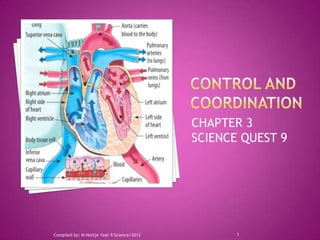
3.3 lung aeroic and anaerobic respiration control and coordination
- 1. CHAPTER 3 SCIENCE QUEST 9 Compiled by: M Nortje Year 9 Science/2012 1
- 2. BLOOD AND CARBON DIOXIDE Compiled by: M Nortje Year 9 Science 2
- 3. Did you know that your body is more sensitive to changes in levels of carbon dioxide than oxygen? Ifthere is too much carbon dioxide in your body, it dissolves in the liquid part of blood and forms an acid. The resulting acidic blood can affect the functioning of your body. Compiled by: M Nortje Year 9 Science 3
- 4. The amount of carbon dioxide in your blood influences your breathing rate. The level of carbon dioxide in the blood is detected by receptors in the walls of some arteries and in the brain. Ifthe levels of carbon dioxide in your blood increase, your breathing rate will be increased so that carbon dioxide can be exhaled from your lungs and passed out of your body. Compiled by: M Nortje Year 9 Science 4
- 5. If you were to climb up high on a mountain, you would need time for your body to adjust. Initially you would feel tired and out of breath because you would be restricted by the limited amount of oxygen available to your cells. Your breathing and heart rate would increase in an effort to get more oxygen around your body. In time, your body would begin to produce more red blood cells and hence more haemoglobin. After this, your breathing and heart rate would return to normal. Compiled by: M Nortje Year 9 Science 5
- 6. Glucose is an example of a nutrient that may be released from digested food. Itis absorbed in your small intestine and then taken by the capillaries to cells for use in cellular respiration. In this process the glucose is combined with oxygen, and is then broken down into carbon dioxide (a waste product that needs to be removed from the cell) and water. Compiled by: M Nortje Year 9 Science 6
- 7. During this reaction energy, in the form of ATP (adenosine triphosphate), is also released. ATP provides the cells with the energy needed to perform many of its activities, and is essential to life. Compiled by: M Nortje Year 9 Science 7
- 8. Glucose+ oxygen → carbon dioxide + water + energy (ATP) Compiled by: M Nortje Year 9 Science 8
- 9. This is an example of systems working together. Glucose is supplied via the digestive system and oxygen is supplied via the respiratory system. The circulatory system transports nutrients (such as glucose) and oxygen to your cells and removes wastes (such as carbon dioxide) from your cells. These wastes are then removed from your body by your excretory systems. Without a supply of glucose and oxygen, cellular respiration could not occur. Without removal of wastes, your cells may die. If you systems did not work together like they do, you would not be able to stay alive. Compiled by: M Nortje Year 9 Science 9
- 10. Compiled by: M Nortje Year 9 Science 10
- 11. Compiled by: M Nortje Year 9 Science 11
- 12. Compiled by: M Nortje Year 9 Science 12
- 13. A supply of energy to keep it working efficiently. During exercise the body needs more energy than usual. Energy for the cells of the body comes from chemical reactions. Compiled by: M Nortje Year 9 Science 13
- 14. The energy is stored in a chemical called ATP. Muscles use ATP as a source of energy. →glucose + oxygen carbon dioxide + water + (36–38) ATP The glucose comes from the food we eat and the oxygen comes from the air we breathe. Endurance sports like running a marathon or playing netball or football use energy released by aerobic respiration. The body has another chemical reaction called anaerobic respiration: glucose lactic acid + (2) ATP Compiled by: M Nortje Year 9 Science 14
- 15. →glucose + oxygen carbon dioxide + water + (36–38) ATP Compiled by: M Nortje Year 9 Science 15
- 16. makes a lot of energy in cells uses oxygen and glucose makes large amounts of energy over a long period of time. Compiled by: M Nortje Year 9 Science 16
- 17. glucose lactic acid + (2) ATP Compiled by: M Nortje Year 9 Science 17
- 18. gives less energy than aerobic respiration gives energy to cells quickly does not use oxygen makes lactic acid which builds up in our muscles. Compiled by: M Nortje Year 9 Science 18
- 19. Lacticacid build-up makes our muscles feel sore after exercise. During a 1500 m race, 55% of the ATP used would be made by anaerobic respiration. ATP can be stored in the cells of the body for a short time. This gives us an energy source that is very good for sports that do not last too long, like 100 m sprints or high jumping. Compiled by: M Nortje Year 9 Science 19